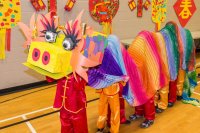Sharing Holiday Traditions in the Classroom
Finding simple ways to celebrate different holidays in the classroom can create a culture of inclusion and deepen understanding.
Your content has been saved!
Go to My Saved Content.I’m full of warm and fuzzy memories of holiday celebrations from my time as a student: the annual Thanksgiving dinner in the gymnasium, the Halloween parade of costumes, Christmas concert preparations and presentations, and Easter egg painting.
Holiday celebrations and traditions are often the most exciting part of the school year for kids and teachers, but how do we navigate holidays and traditions while creating a classroom that is inclusive and respectful?
Strategies in classrooms and schools allow teachers to navigate any holiday or special event respectfully with academic benefits as well. Select holidays and religious celebrations based on your classroom representation. When I get more diverse classrooms, I do my best to celebrate more prominent holidays, learn about ones that would be new to most of my students, and at least share a quick video or do a small activity to acknowledge them.
Learn About Each Other
Knowing and learning about classmates’ and teachers’ cultural backgrounds, religions, families, and traditions at the beginning of the school year reduces fear and increases empathy. It also creates a platform where students can ask questions and break down stereotypes. Because some students and parents may be resistant at first, I send a message home at the beginning of the school year outlining our purpose in celebrating different holidays as part of my general introduction letter. I usually include a section that reads: “We are excited to learn about each other’s families, cultures, holidays, and celebrations throughout the school year. If you would like to volunteer to share a cultural holiday, meal, or celebration with us, please contact me via the signature information below.”
As a result of my invitation through the introductory letter, I have had many parents come forward to share and take part in celebrations with us. We’ve burned sweetgrass, displayed traditional costumes from various cultures, danced to traditional holiday songs from many areas of the world—and of course cooked and tried many holiday dishes.
Identity Collage: Students can create and present a visual collage that represents their ancestry, religion, and family. Teachers can also complete and present this activity.
10 Questions: Ask students to create a list of 10 get-to-know-you questions, and then allow students to interact with each other. Each pair of students then introduces their partner to the class. Often, students will require example questions to get them started. I usually start with a brainstorming list of questions students can use and leave them on the board throughout the duration of this activity.
Possible questions might include:
- How many places have you lived?
- Where have you traveled?
- What’s your favorite pastime?
- What’s your favorite holiday?
- Do you play sports?
- What’s your favorite subject in school?
- What’s your cultural background?
- How many people are in your family?
- Do you have any pets?
- What’s your favorite food?
Line Game: Use a tape to create a line on the classroom floor. Then ask students questions such as “Who has a sibling?” or “Who has lived in another country?” and have any students with that experience stand on the line. Students can ask questions, and the teacher can participate as well. The game provides a low-risk way for students to share information about their experiences and backgrounds.
Incorporate Academics
Why do we celebrate or acknowledge holidays and traditions? How did these holidays and traditions develop? Often, students have no idea about the origins of the holidays or traditions they celebrate. Learning about them allows for academic study and discussion about why they exist.
Expand the focus beyond North American holidays and traditions. My favorite way to expand our focus is to start with a History Channel video about holidays and traditions from a variety of cultures and religions. I find that they are short and engaging, and often come with activities and resources for teachers. Once viewing is complete, you can follow up with a variety of different activities to deepen learning. For example, after viewing, I will ask students to write a paragraph about an element of the film. Group discussions about the content can also be a good starting point for understanding different holidays and faiths.
Films are not the only mechanism for fostering better understanding. Inviting leaders of different faith traditions to the classroom to share their experiences can be a personalized way to improve understanding. I invite a local indigenous leader to my classroom to share about his traditions and oral creation stories. He usually also burns sweetgrass as part of this activity, and my students have always been interested and engaged in this experience that is foreign to most of them. Students gain a more nuanced understanding of the neighboring indigenous traditions by hearing in person from a local leader.
Celebrate Everything
If you’re learning about a variety of holidays and traditions around the world that have specific celebration dates, they should be celebrated in your classroom the same way you would celebrate traditional North American holidays and traditions. Simple strategies such as inviting students to dress a certain way, create a piece of art, share food, sing a song, or write something related to the holiday or tradition can help students appreciate others’ holidays and traditions.
Whatever method of celebration you choose, the fact that you are stopping your regular classroom activities to show respect to all holidays and traditions celebrated by your students creates an environment of acceptance and inclusivity.
